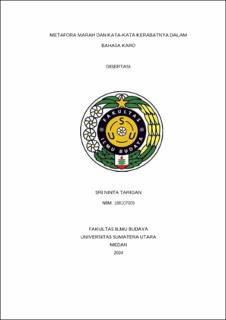| dc.description.abstract | This study investigates conceptual metaphors found in the metaphorical domain of ANGER and its related terms in the Karo language. The research addresses three main questions: (1) What conceptual metaphors are found for the target domain of ANGER and its related terms in the Karo language? (2) What are the metaphorical patterns of ANGER and its related terms in the Karo language? (3) What are the metaphorical prototypes and conceptual meanings of ANGER and its related terms in the Karo language. The objectives of this study are to identify the metaphorical concepts of ANGER and its related terms in the Karo language, describe the metaphorical patterns found in ANGER metaphors and their related terms, and delineate the prototypes of each ANGER metaphor and its related terms. This research employs a qualitative approach with a descriptive analysis of the identified metaphors. The distributional method was used, where all data were recorded, transcribed, and categorized according to the ANGER metaphor categories. The collected data were then classified into the Source Domain and Target Domain. The findings reveal that the metaphor MERAWA is the most frequently used metaphor for ANGER in the Karo language, while the metaphor LUAM is the least used. In terms of metaphorical patterns and prototypes, MERAWA, NEMBEN, and GARA dominate both structural patterns and prototypical representations, whereas LUAM is the least frequent. The analysis identified the following related terms for ANGER metaphors: merawa, nembeh, ngilas, gara, luam, and naik dareh. From the concept of MERAWA, the most dominant conceptual metaphor is ANGER IS A NATURAL FORCE. In NEMBEH, GARA, and NGILAS, the dominant conceptual metaphor is ANGER IS FIRE, while in LUAM, the dominant conceptual metaphor is ANGER IS A BURDEN. Additionally, the conceptual metaphors ANGER IS FIRE, MADNESS, A CAPTIVE BEAST, and A BURDEN were identified as dominant representations of ANGER in the Karo language. The distribution of metaphorical patterns shows that MERAWA appears at the beginning of a sentence 22 times, in the middle 178 times, and at the end 75 times. NEMBEH appears at the beginning 20 times, in the middle 163 times, and at the end 37 times. NGILAS appears at the beginning 20 times, in the middle 102 times, and at the end 16 times. GARA appears at the beginning 3 times, in the middle 5 times, and at the end 4 times. LUAM appears at the beginning 5 times, in the middle 4 times, and at the end 3 times. Lastly, NAIK DAREH appears at the beginning 6 times, in the middle 2 times, and at the end 4 times. The findings indicate that metaphorical patterns occurring in the middle of sentences dominate the conceptual metaphors of ANGER and its related terms in the Karo language. The prototypical concept of ANGER and its related terms includes the presence of danger, the emergence of emotions, efforts to control them, loss of control, and their release. | en_US |


